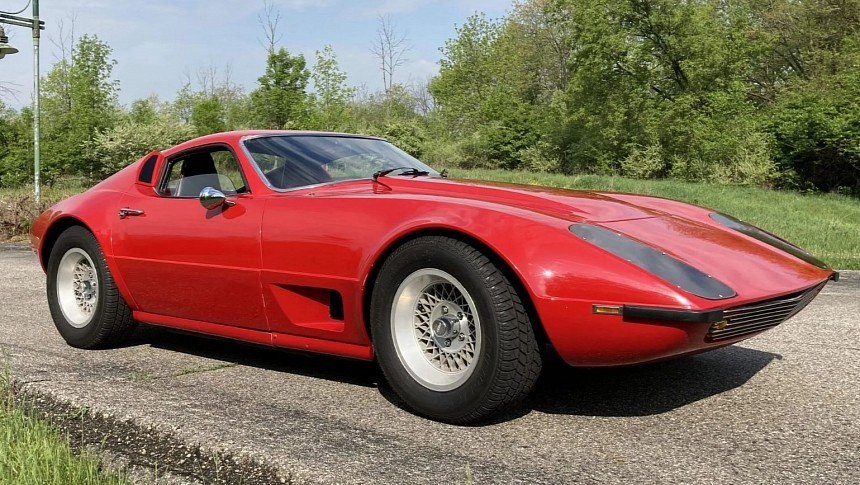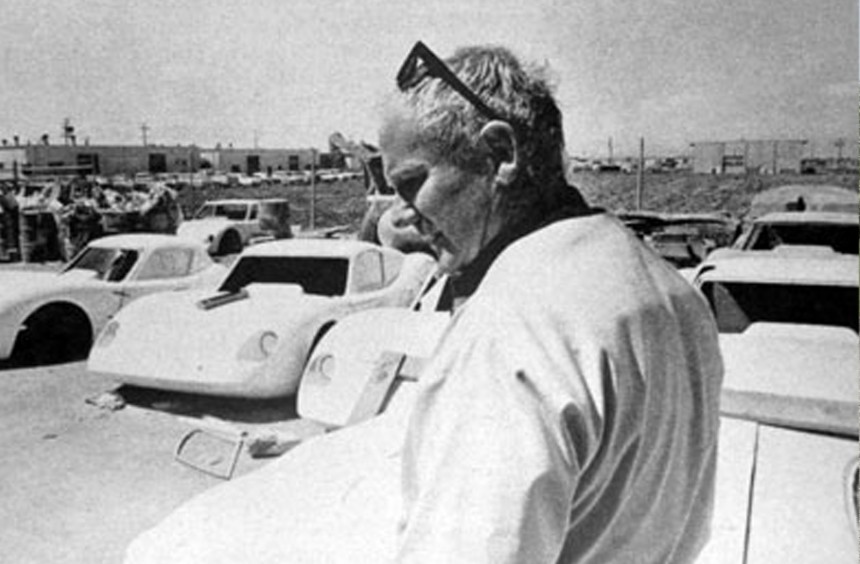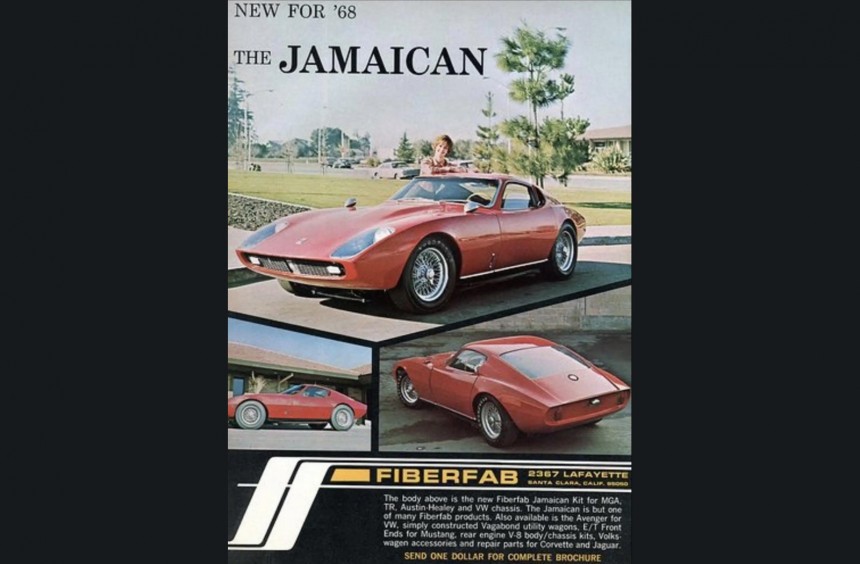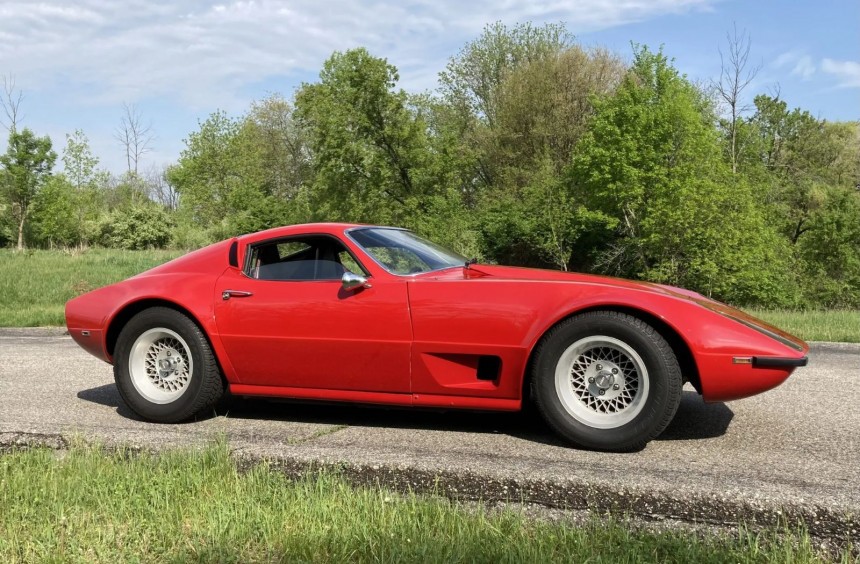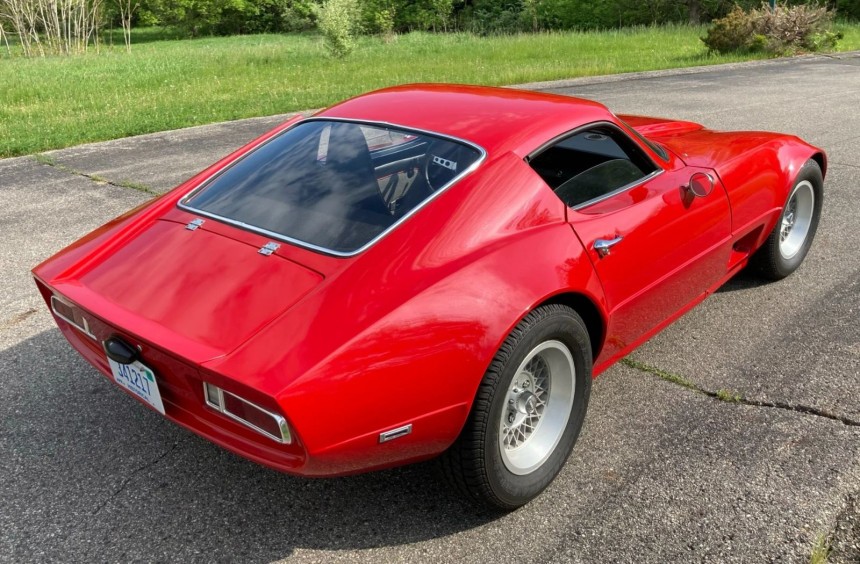A super GT that looked like the perfect combination between the Ferrari Daytona and the Lamborghini Miura, the fiberglass-bodied Jamaican II was conceived in the US on a bespoke chassis equipped with good-ol'-fashioned V8 muscle.
What I love most about my job is finding awesome cars that few have ever heard about, and one of the best ways of doing that is to explore the world of kit cars.
For those unfamiliar with this notion, a kit car is usually an affordable custom fiberglass body delivered as a set of parts for the owner to assemble. Some kits are designed to be mated to existing chassis and drivetrains, while others come with bespoke frames on which owners can fit their choice of engines and transmissions.
Kit cars are rarer today, but back in the 1960s and 1970s, those who wanted one were spoilt for choice. In the US, One of the companies that offered a wide range of awesome kits was Fiberfab, the creators of the exquisite Jamaican II grand tourer.
The story of Fiberfab starts in the 1950s, a decade that saw the emergence of fiberglass-bodied sports cars like the Kaiser Darrin 161, Glasspar G2, or the more popular, first-generation Corvette.
It was founded in 1956 as Sports Car Engineering (SCE) by an amateur race driver named Warren "Bud" Goodwin, who built his own custom race car and saw this as a business opportunity.
SCE started out small, building bolt-on fiberglass body kits for a range of existing sports cars and proprietary tube chassis, which stood out for being integrated inside the bodies. The company was relatively successful from the start, attracting interest from potent investors, which led Goodwin to sell it for a sizable profit to Du Crest Fiberglass in 1958.
However, he didn't give up on the kit car industry, and in 1964, with the money he made from selling SCE, Goodwin established another company called Fiberfab in Palo Alto, California. The business started out small, building custom parts for existing models, then began developing and selling complete body kits. In just three years, Fiberfab became one of the premier kit car manufacturers in the world, offering a wide range of models that were sold all around the globe.
But, in 1967, tragedy struck as Bud Goodwin was arrested on suspicion of shooting his 28-year-old wife, Jamaica. He was eventually found guilty of voluntary manslaughter and sentenced to twelve months in prison, where he died from a heart attack. Despite this, Fiberfab continued to develop exciting kit cars for the next decade. It switched owners and headquarters multiple times but slid into anonymity, then finally ceased operations in 1980.
Fiberfab's flagship product was the Valkyrie, introduced in 1966. Available as a $1,495 kit or a $12,500 ready-to-run car powered by a Chevy 427, the Valkyrie was heavily inspired by the Frod GT40, but by all accounts, it looked far worse.
In 1968, the company announced a new kit called Jamaican in honor of the founder's late wife. Designed by Chris and Russell Beebe, the Lamborghini Miura-inspired grand tourer was undoubtedly the prettiest fiberglass body that Fiberfab had ever conceived.
Initially, the Jamaican was meant to replace the original bodywork of several compact British sports cars like the Triumph TR3 and TR4, the MG MGA, or several Austin-Healeys. But, only a few months after its introduction, the company was already overwhelmed by the vast number of requests for a more powerful version that could accommodate an American V8.
Chris and Russell Beebe, who had just finished the molds for the first Jamaican, got back to the drawing board and designed a wider, longer-wheelbase version that could comfortably house an eight-cylinder.
However, unlike the previous version, the new body would not fit on the British chassis, so they also put together a bespoke tubular steel frame. To keep costs low, the structure was designed to be compatible with mechanical components from existing American models and could easily be fitted with a wide range of muscle car V8s.
While the initial Jamaican body was praised for its European looks, the revised version's proportions resulted in an even better package that made the vehicle look nothing like a kit car but more like an exquisite grand tourer handbuilt by one of the renowned coachbuilders from Italy.
Its long and sharp front end was perfectly complemented by curvaceous wheel arches and a subtle hood cowl, whereas its low-slung roof line and short fastback-style rear end completed the authentic European grand tourer look.
The Jamaican II V8 was gorgeous from every angle, looking sexy yet menacing at the same time. Without going overboard on the mechanical parts of the drivetrain, it was cheaper to build than a brand-new, optioned-out C3 Corvette, and it looked better - at least in my opinion.
This lightweight fiberglass beauty became one of Fiberfab's best-sellers, with most owners choosing to power it with either Chevy small-blocks or Buick/Rover all-aluminum units.
Though there's no official record of how many Jamaican IIs were built, plenty of them are still around and can be found all over the internet. Many were neglected and can be brought in a deplorable state by someone willing to take on ambitious restoration progress, but with a little bit of patience and luck, you can find one that's still in good condition for less than $25k.
A great example is the red Jamaican II that you can admire in the gallery above. It poped-up on the Bring a Trailer platform last year and sold for $24,250. Though not a Concurs-level example, the car was looked after and ran smoothly, according to the seller.
Brought as a kit, this particular Jamaican II was completed during the 1980s and received a 5.7-liter Chevy small-block linked to a Turbo-Hydramatic three-speed auto. Additionally, it received a Corvette rear end, a fully-independent suspension system - Ford-sourced at the front and C3 at the rear - and, for some reason, drum brakes all around.
So, if you're looking for an absolutely stunning vintage sports car with an exciting story, but you're on a tight budget, the Fiberfab Jamaican II V8 deserves serious consideration.
For those unfamiliar with this notion, a kit car is usually an affordable custom fiberglass body delivered as a set of parts for the owner to assemble. Some kits are designed to be mated to existing chassis and drivetrains, while others come with bespoke frames on which owners can fit their choice of engines and transmissions.
Kit cars are rarer today, but back in the 1960s and 1970s, those who wanted one were spoilt for choice. In the US, One of the companies that offered a wide range of awesome kits was Fiberfab, the creators of the exquisite Jamaican II grand tourer.
A story that seems inspired by a Hollywood script
It was founded in 1956 as Sports Car Engineering (SCE) by an amateur race driver named Warren "Bud" Goodwin, who built his own custom race car and saw this as a business opportunity.
SCE started out small, building bolt-on fiberglass body kits for a range of existing sports cars and proprietary tube chassis, which stood out for being integrated inside the bodies. The company was relatively successful from the start, attracting interest from potent investors, which led Goodwin to sell it for a sizable profit to Du Crest Fiberglass in 1958.
However, he didn't give up on the kit car industry, and in 1964, with the money he made from selling SCE, Goodwin established another company called Fiberfab in Palo Alto, California. The business started out small, building custom parts for existing models, then began developing and selling complete body kits. In just three years, Fiberfab became one of the premier kit car manufacturers in the world, offering a wide range of models that were sold all around the globe.
But, in 1967, tragedy struck as Bud Goodwin was arrested on suspicion of shooting his 28-year-old wife, Jamaica. He was eventually found guilty of voluntary manslaughter and sentenced to twelve months in prison, where he died from a heart attack. Despite this, Fiberfab continued to develop exciting kit cars for the next decade. It switched owners and headquarters multiple times but slid into anonymity, then finally ceased operations in 1980.
Developing the first Jamaican
In 1968, the company announced a new kit called Jamaican in honor of the founder's late wife. Designed by Chris and Russell Beebe, the Lamborghini Miura-inspired grand tourer was undoubtedly the prettiest fiberglass body that Fiberfab had ever conceived.
Initially, the Jamaican was meant to replace the original bodywork of several compact British sports cars like the Triumph TR3 and TR4, the MG MGA, or several Austin-Healeys. But, only a few months after its introduction, the company was already overwhelmed by the vast number of requests for a more powerful version that could accommodate an American V8.
The Jamaican II V8
However, unlike the previous version, the new body would not fit on the British chassis, so they also put together a bespoke tubular steel frame. To keep costs low, the structure was designed to be compatible with mechanical components from existing American models and could easily be fitted with a wide range of muscle car V8s.
While the initial Jamaican body was praised for its European looks, the revised version's proportions resulted in an even better package that made the vehicle look nothing like a kit car but more like an exquisite grand tourer handbuilt by one of the renowned coachbuilders from Italy.
Its long and sharp front end was perfectly complemented by curvaceous wheel arches and a subtle hood cowl, whereas its low-slung roof line and short fastback-style rear end completed the authentic European grand tourer look.
The Jamaican II V8 was gorgeous from every angle, looking sexy yet menacing at the same time. Without going overboard on the mechanical parts of the drivetrain, it was cheaper to build than a brand-new, optioned-out C3 Corvette, and it looked better - at least in my opinion.
You can have one today for less than $25k
Though there's no official record of how many Jamaican IIs were built, plenty of them are still around and can be found all over the internet. Many were neglected and can be brought in a deplorable state by someone willing to take on ambitious restoration progress, but with a little bit of patience and luck, you can find one that's still in good condition for less than $25k.
A great example is the red Jamaican II that you can admire in the gallery above. It poped-up on the Bring a Trailer platform last year and sold for $24,250. Though not a Concurs-level example, the car was looked after and ran smoothly, according to the seller.
Brought as a kit, this particular Jamaican II was completed during the 1980s and received a 5.7-liter Chevy small-block linked to a Turbo-Hydramatic three-speed auto. Additionally, it received a Corvette rear end, a fully-independent suspension system - Ford-sourced at the front and C3 at the rear - and, for some reason, drum brakes all around.
So, if you're looking for an absolutely stunning vintage sports car with an exciting story, but you're on a tight budget, the Fiberfab Jamaican II V8 deserves serious consideration.
